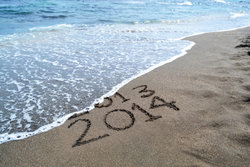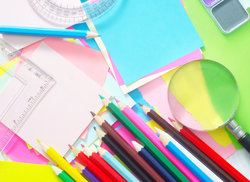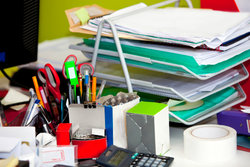My big ELT clear-out

Since my post on the CPD checklist a year ago, 2013 has been an eventful year of change and of learning.
At the start of 2013, I moved my country of residence and had to adapt to a totally different teaching context where I had to get used to in-company training rather than in-school training. In the type of courses that I was conducting, it became apparent that the need for cross-cultural training is an important part of helping our learners become better communicators.
I had to stop and reflect upon the different roles that a language teacher fulfils, and consider how we as teachers might no longer simply be knowledge owners and knowledge givers, but knowledge facilitators.
As a teacher trainer, I realised that I should practise what I preach when training the trainers and avoid being too prescriptive.
I also had to embrace the possibility that the training I offer does not only entail language work but also management skills training and accept the fact that my clients are using English to communicate internationally and that teaching English might no longer require the teaching of English culture.
By using internet videos, corpora and concordances, and questioning the way we test our students, we might be able to make our lessons more relevant to our students and the world they live in.
And let’s not forget that while our first language is no doubt part of our identity, our learners’ second language is also part of their identities.
Living in a non-English speaking country and being a new elementary user of the local language, I found myself re-examining the unquestioned mantras that are often blindly followed in the language classroom and remembering that what’s obvious to the language teacher and the native speaker may not be so to a learner less familiar with the language or teaching methodology.

At the end of 2013, as I moved countries again, I realised that I had boxes and boxes of ELT-related ‘junk’ that I had been moving from country to country, house to house. And I had to confront the fact that it was perhaps time for me to do a big clear-out.
In going through my ELT ‘junk’, I could perhaps categorise them into the following categories:
Lesson Materials
- This includes old lesson plans, photocopies of lesson materials, old course books and text books.
Supplementary Resources & Props
- This includes flashcards, photocopied make-shift board games, laminated cards, dice, Cuisenaire rods, etc.
CPD (Continual Professional Development) materials
- This includes books on understanding language, teaching methodology and language acquisition, ELT journals like ETp and MET (pardon the shameless plug), essays and readings from courses you have taken.
Stationery
- This includes board markers, OHP acetate and pens, folders, hundreds of pens that I have collected from conferences and ELT-related events, etc.
The Miscellaneous ELT stuff
- This includes pictures that my ex-students drew, photocopies of the lovely feedback I got, those posters from the Guardian newspaper showing the different types of birds/dinosaurs/natural disasters, conference lanyards, etc.

As I tried to reduce and streamline my ELT-related items, here are some tips that have helped me. So if you are aiming for a big clear-out in the new year, perhaps they can help you too.
Lesson materials
- Ask yourself: When was the last time I used this in a lesson? If the answer is ‘more than a year ago’, then place it in one of the following two categories: ‘Dump it!’ or ‘Use it within the next 3 months’. And if you fail to use it within the next 3 months, then dump it.
- Have you stored this on a USB stick, backed it up on a hard drive, and/or have it in the cloud? If so, why is there a need to keep the hard copy? And if not, how can you get it stored digitally?
- Is this material something you have been using on every course you’ve taught? Are you bored of it? Are you really using it because it’s the only effective way to teach that language point? Is it time to get rid of it? Or at least adapt it?
- Put all the materials for each lesson together in a clear plastic pocket and stick it in a ring folder. Create a content page for the folder so that they are easy to find.
- Are the course books/textbooks from pre-2000? Do you still use them? Why are they there?
- Are the exam preparation books current and up to date? Could you get better exam practice activities online?

Supplementary Resources & Props
- Is there an app for that? Whether they be flashcards, dice, puppets, there’s probably an app for that which you can download on your smart phone or tablet. You might even find it on the Interactive White Board in your classroom. So do you really need them?
- Instead of bringing actual flashcards with you, how about creating them to store on your tablet? The easiest way to do so is to take a photo of the flashcard and store it in your gallery. That way, you can have all of them accessible at your fingertips and they won’t weigh a ton to carry around with you.
CPD (Continual Professional Development) materials
- Put the articles and journals that you intend to read but keep putting off in visible and easily-accessible locations e.g. a magazine rack in your living room or bathroom. Or put some in your bag and read them on the way to work.
- Or better yet, can you find these articles online? Download them onto your mobile device and get rid of the hard copies.
- Have you read your methodology and reference books? Do you know them cover to cover? Is there any reason to keep them? Might another teacher benefit from them? Start the new year generously and give away a few books or donate them to the school library!

Stationery
- Do the pens still work? Are you keeping markers that have dried up?
- Is your stationery in an accessible place? There’s no point keeping OHP acetate, cuisenaire rods or dice in case you might need to use them when they aren’t with you when that need arises.
The Miscellaneous ELT stuff
- Are you keeping it for sentimental reasons? A conference brochure? Your first lesson plan? A poster your students made in class? How about taking a photo of it and storing it digitally instead?
- Conference bags make good shoe bags when travelling. Conference lanyards come in handy when role-playing social events. Photocopies done on one side of an A4 sheet make good scrap paper. Are there any other ways to re-use some of this stuff? If not, can they be recycled?
Clearing out the old will make space for the new. So once you’ve de-cluttered a bit, get yourself a couple of new books and keep learning!
And have a great start to 2014!



Comments
Write a Comment
Comment Submitted